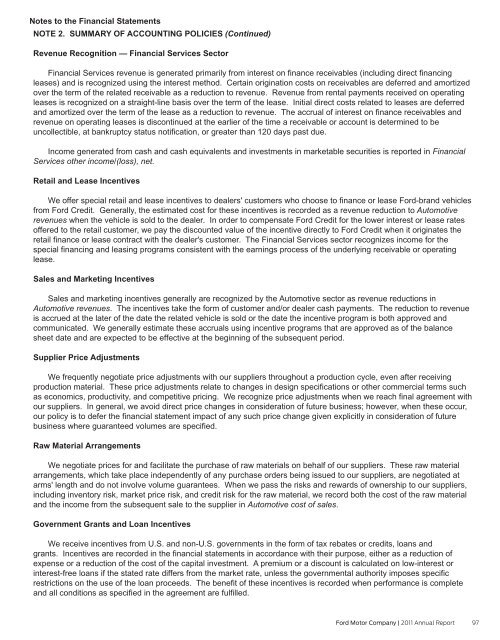PROFITABLE GROWTH FOR ALL
You also want an ePaper? Increase the reach of your titles
YUMPU automatically turns print PDFs into web optimized ePapers that Google loves.
Notes to the Financial Statements<br />
NOTE 2. SUMMARY OF ACCOUNTING POLICIES (Continued)<br />
Revenue Recognition — Financial Services Sector<br />
Financial Services revenue is generated primarily from interest on finance receivables (including direct financing<br />
leases) and is recognized using the interest method. Certain origination costs on receivables are deferred and amortized<br />
over the term of the related receivable as a reduction to revenue. Revenue from rental payments received on operating<br />
leases is recognized on a straight-line basis over the term of the lease. Initial direct costs related to leases are deferred<br />
and amortized over the term of the lease as a reduction to revenue. The accrual of interest on finance receivables and<br />
revenue on operating leases is discontinued at the earlier of the time a receivable or account is determined to be<br />
uncollectible, at bankruptcy status notification, or greater than 120 days past due.<br />
Income generated from cash and cash equivalents and investments in marketable securities is reported in Financial<br />
Services other income/(loss), net.<br />
Retail and Lease Incentives<br />
We offer special retail and lease incentives to dealers' customers who choose to finance or lease Ford-brand vehicles<br />
from Ford Credit. Generally, the estimated cost for these incentives is recorded as a revenue reduction to Automotive<br />
revenues when the vehicle is sold to the dealer. In order to compensate Ford Credit for the lower interest or lease rates<br />
offered to the retail customer, we pay the discounted value of the incentive directly to Ford Credit when it originates the<br />
retail finance or lease contract with the dealer's customer. The Financial Services sector recognizes income for the<br />
special financing and leasing programs consistent with the earnings process of the underlying receivable or operating<br />
lease.<br />
Sales and Marketing Incentives<br />
Sales and marketing incentives generally are recognized by the Automotive sector as revenue reductions in<br />
Automotive revenues. The incentives take the form of customer and/or dealer cash payments. The reduction to revenue<br />
is accrued at the later of the date the related vehicle is sold or the date the incentive program is both approved and<br />
communicated. We generally estimate these accruals using incentive programs that are approved as of the balance<br />
sheet date and are expected to be effective at the beginning of the subsequent period.<br />
Supplier Price Adjustments<br />
We frequently negotiate price adjustments with our suppliers throughout a production cycle, even after receiving<br />
production material. These price adjustments relate to changes in design specifications or other commercial terms such<br />
as economics, productivity, and competitive pricing. We recognize price adjustments when we reach final agreement with<br />
our suppliers. In general, we avoid direct price changes in consideration of future business; however, when these occur,<br />
our policy is to defer the financial statement impact of any such price change given explicitly in consideration of future<br />
business where guaranteed volumes are specified.<br />
Raw Material Arrangements<br />
We negotiate prices for and facilitate the purchase of raw materials on behalf of our suppliers. These raw material<br />
arrangements, which take place independently of any purchase orders being issued to our suppliers, are negotiated at<br />
arms' length and do not involve volume guarantees. When we pass the risks and rewards of ownership to our suppliers,<br />
including inventory risk, market price risk, and credit risk for the raw material, we record both the cost of the raw material<br />
and the income from the subsequent sale to the supplier in Automotive cost of sales.<br />
Government Grants and Loan Incentives<br />
We receive incentives from U.S. and non-U.S. governments in the form of tax rebates or credits, loans and<br />
grants. Incentives are recorded in the financial statements in accordance with their purpose, either as a reduction of<br />
expense or a reduction of the cost of the capital investment. A premium or a discount is calculated on low-interest or<br />
interest-free loans if the stated rate differs from the market rate, unless the governmental authority imposes specific<br />
restrictions on the use of the loan proceeds. The benefit of these incentives is recorded when performance is complete<br />
and all conditions as specified in the agreement are fulfilled.<br />
Ford Motor Company | 2011 Annual Report 97


